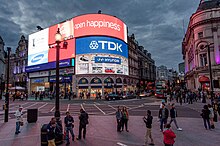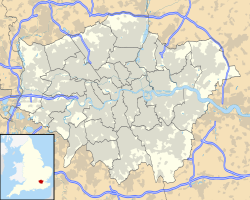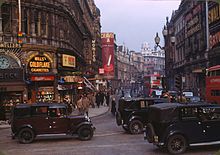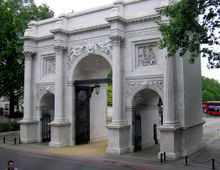West End (London)
Location of West End in Greater London |


The West End of London is a district in the center of the British capital in the City of Westminster . Many of the city's major tourist attractions, including shopping streets, large corporations, government buildings and entertainment centers, are located in this part of the city. The West End is known internationally for its high concentration of theaters and, along with Broadway in New York City and Hamburg in Germany, is one of the most important locations for stage productions, especially musicals , worldwide.
Territorial boundaries
The area is not exactly delimited, but is commonly understood as the area around Piccadilly Circus , Leicester Square , Trafalgar Square and the surrounding streets. In the City of Westminster there is also an official borough, a so-called ward , called the "West End", which is smaller than the area generally known as this.
The term West End was used from the early 19th century to describe the richer, fancier area west of Charing Cross , also in contrast to London's East End , the city's poorest area. The urban area now includes parts of the boroughs of Westminster and Camden .
While the City of London , due to their surface area and Square Mile ( square mile ) set up economic and financial center of London is home, the West End is the commercial entertainment center of the city. It is the largest city center in the United Kingdom and is comparable to Midtown Manhattan in New York City , Causeway Bay in Hong Kong , Shibuya in Tokyo and the 8th Arrondissement in Paris . The West End is also still one of the most expensive areas in the world in terms of housing and office rental prices, right behind Sand Hill Road in Silicon Valley .
Theatreland and West End theater
The streets Drury Lane , Shaftesbury Avenue and beach are at the heart of this district and are analogous to Broadway as Theatreland referred. The term Theatreland also exists in other larger cities such as Glasgow and always refers to a collection of many (commercial) theaters in a small area. Although other city districts can have a West End, the term West End is internationally associated with the London theater scene in a cultural context. In addition to the London Theatreland theaters, this also includes the non-commercial theaters of the district and sometimes also the other theaters in the London city center. West End theaters include Her Majesty's Theater and Theater Royal Haymarket on Haymarket, the Adelphi Theater and Lyceum Theaters on the Strand, the Royal Opera House in Covent Garden and the Prince Edward Theater .
In addition to the commercial Theatreland theaters, there are other, primarily publicly funded, theaters in London. These include the Royal National Theater , the Royal Shakespeare Company, and the Royal Court Theater . The Globe Theater is a special feature here, as it is an exact replica of a classic Shakespeare theater and is completely financed by the Globe Trust, i. H. does not receive any subsidies. The fringe theaters (roughly: "alternative theater") are another category of theaters or festivals. They can be compared with the New York Off-Broadway and Off-Off-Broadway performances and are sometimes referred to as off- and off-off-West-End by analogy, but these terms have not yet caught on.
The entirety of the great professional London theaters is usually referred to internationally as (the) West End , just as the term Broadway theater encompasses a larger area of the city than just Broadway . Since the term West End is often used synonymously with the London (or even British) theater scene in the cultural field , there is a distinction between the West End of London (whereby between West and End is emphasized or a tiny pause inserted ) to avoid misunderstandings is) and the West End (whereby the words are usually contracted: West ‿ end). This should make it clear that the former is a geographical limitation (west end of ... → western end of ...), while the latter has become a kind of proper name. In addition, the latter sometimes refers to a West End theater, a West End show or the like, if the context was not already clear.
Mainly musicals , comedies and classical or modern plays are played at the London theaters . According to the 1997 Wyndham Report, West End theater sales for that year were £ 1.075 billion and employed 41,000 people.
Major streets and squares
In the West End there are a number of important public spaces ( squares ) and so-called circuses , the original name for the London roundabouts .
Connection
The West End has the following underground stations:
Web links
Individual evidence
- ^ A. Mills: Oxford Dictionary of London Place Names , (2001)
- ↑ Greater London Authority: The London Plan - The Sub Regions ( Memento of the original from June 4, 2011 in the Internet Archive ) Info: The archive link was automatically inserted and not yet checked. Please check the original and archive link according to the instructions and then remove this notice.
- ^ Venture Capital: Sand Hill Road Rules the Valley . In: Bloomberg News , December 4, 2014. Retrieved April 19, 2015.
Coordinates: 51 ° 30 ′ 48 " N , 0 ° 7 ′ 43" W.


